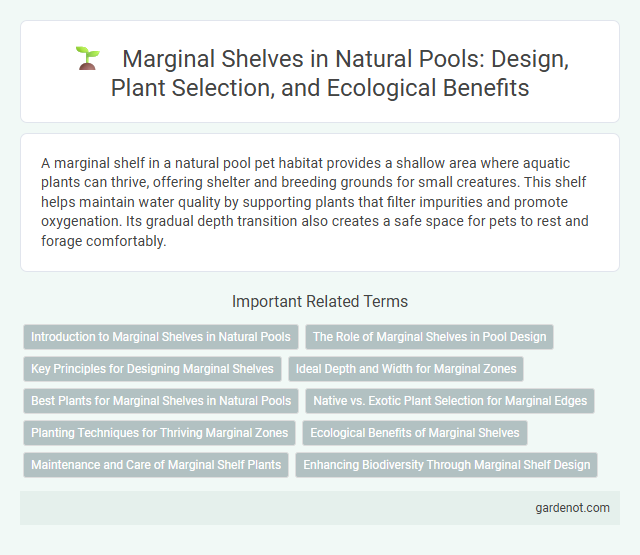A marginal shelf in a natural pool pet habitat provides a shallow area where aquatic plants can thrive, offering shelter and breeding grounds for small creatures. This shelf helps maintain water quality by supporting plants that filter impurities and promote oxygenation. Its gradual depth transition also creates a safe space for pets to rest and forage comfortably.
Introduction to Marginal Shelves in Natural Pools
Marginal shelves in natural pools serve as shallow transitional zones where aquatic plants thrive, enhancing water filtration and habitat diversity. These shelves stabilize pool edges, reducing erosion while supporting biodiversity by providing refuge for small aquatic organisms. Incorporating marginal shelves improves the ecological balance and visual appeal of natural swimming environments.
The Role of Marginal Shelves in Pool Design
Marginal shelves in natural pool design create shallow zones that support aquatic plants, improving water filtration and ecosystem balance. These shelves enhance habitat diversity by providing safe areas for wildlife while also facilitating gradual access and aesthetic appeal. Incorporating marginal shelves optimizes biological filtration, reduces algae growth, and stabilizes water quality naturally.
Key Principles for Designing Marginal Shelves
Marginal shelves in natural pool design create a gradual transition between shallow and deep water, supporting aquatic plants that enhance water filtration and biodiversity. Key principles include maintaining a gentle slope of 1:10 to 1:12 for safe footing and maximizing sunlight exposure for optimal photosynthesis. Select native plant species with varying root depths to stabilize the substrate and reduce algal growth naturally.
Ideal Depth and Width for Marginal Zones
The ideal depth for marginal shelves in natural pools ranges from 15 to 30 centimeters, providing optimal conditions for aquatic plants while ensuring safety and accessibility. Widths between 60 and 120 centimeters allow sufficient space for diverse wetland vegetation to establish and promote natural filtration. Properly dimensioned marginal zones support biodiversity and enhance the ecological balance of the natural pool.
Best Plants for Marginal Shelves in Natural Pools
Marginal shelves in natural pools provide shallow water zones perfect for aquatic plants like water lilies, cattails, and iris, which enhance water filtration and habitat diversity. Choosing oxygenating plants such as frogbit or water hawthorn supports clear water by absorbing excess nutrients and preventing algae growth. Incorporating native species like pickerelweed or marsh marigold ensures ecological balance and promotes a thriving ecosystem on the marginal shelf.
Native vs. Exotic Plant Selection for Marginal Edges
Selecting native plants for the marginal shelf of a natural pool enhances habitat stability and supports local biodiversity by providing specialized root systems that filter water naturally. Exotic species may disrupt the ecological balance, outcompeting native flora and potentially introducing pests or diseases. Prioritizing native vegetation ensures optimal water quality management and promotes a sustainable ecosystem tailored to the regional climate and soil conditions.
Planting Techniques for Thriving Marginal Zones
Planting techniques for thriving marginal shelves in natural pools emphasize selecting native aquatic plants with strong root systems that stabilize the substrate and filter water. Incorporating zoned planting strategies, such as layering emergent and submergent species, maximizes habitat diversity and nutrient absorption. Regular monitoring of water quality and adaptive planting maintains a balanced ecosystem, promoting long-term health and clarity in the marginal zone.
Ecological Benefits of Marginal Shelves
Marginal shelves in natural pools create shallow zones that support diverse aquatic plants, enhancing habitat complexity and promoting biodiversity. These shelves improve water quality through natural filtration by rooted vegetation, reducing nutrient loads and preventing algae blooms. By providing safe spawning grounds and shelter for various aquatic species, marginal shelves contribute significantly to the ecological balance of natural pool ecosystems.
Maintenance and Care of Marginal Shelf Plants
Maintaining marginal shelf plants in a natural pool requires regular trimming to prevent overgrowth and ensure healthy root development. Monitoring water quality by checking pH and nutrient levels helps avoid algae buildup that can harm plants. Seasonal removal of dead or decaying foliage supports optimal plant health and promotes biodiversity in the pool ecosystem.
Enhancing Biodiversity Through Marginal Shelf Design
Marginal shelves in natural pools significantly enhance biodiversity by creating shallow, sunlit zones that support diverse aquatic plants and microhabitats essential for various invertebrates, amphibians, and small fish. These transitional areas improve water quality by promoting nutrient uptake through plant roots and provide refuge for wildlife, fostering a balanced ecosystem. By optimizing the design and placement of marginal shelves, natural pools sustain higher species richness and ecological resilience.
Marginal shelf Infographic

 gardenot.com
gardenot.com